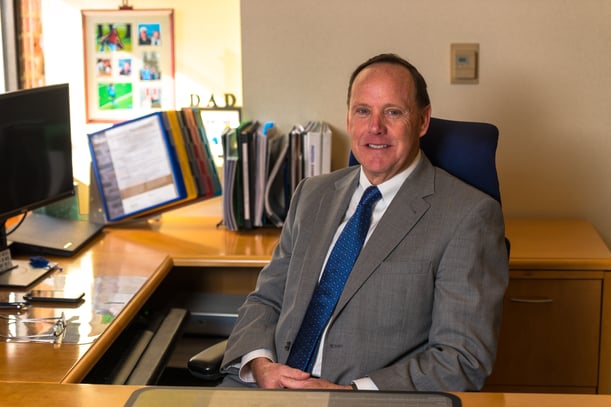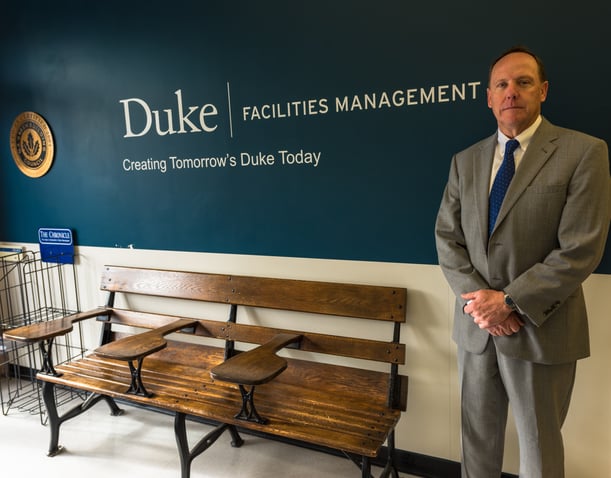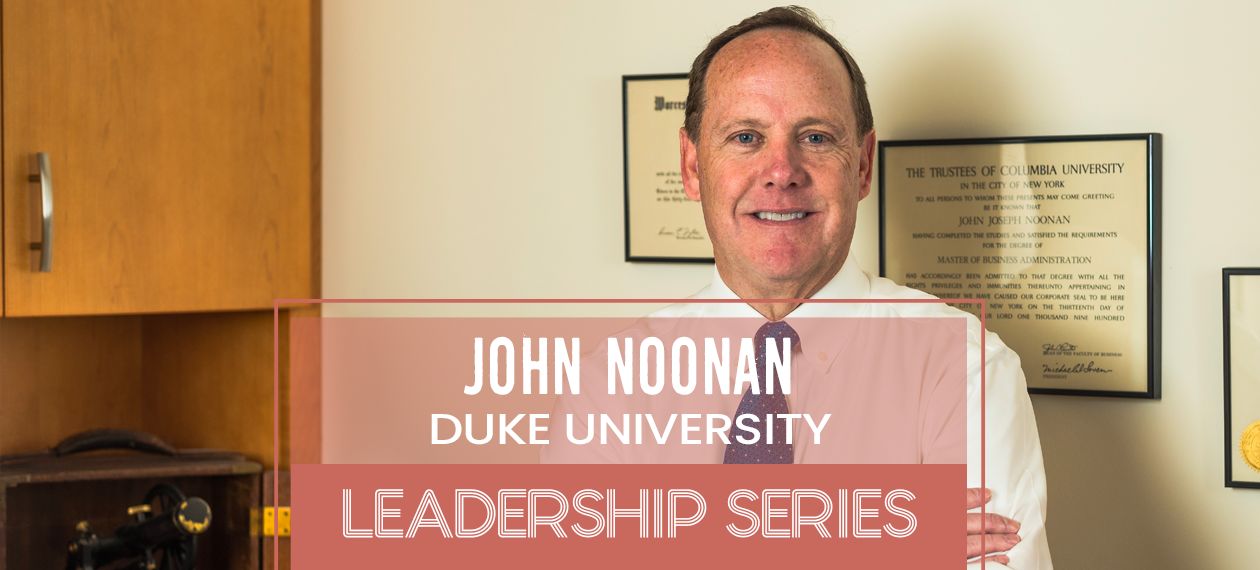"How sustainable is it to continue to build at the pace that the top universities have for many years?"
This is just one question John Noonan, who has been Vice President for Facilities at Duke University since 2011, raises during our conversation about both the current and future facilities needs in higher ed. Noonan, who came to Duke in 2005 after 13 years at Brown, previously held positions in engineering/project management firms, and residential and commercial real estate development.
Now, he's responsible for the oversight of Duke's campus buildings and grounds and a workforce of about 600 staff. We caught up with Noonan to hear his take on effective leadership, how he's handling Duke’s ambitious capital program, and what universities can do to thrive in the future...
Did you always know higher ed facilities would be your career path?
Honestly, no, it was completely unplanned. I was working in a consulting firm in Boston, and the VP of the firm knew the facilities person at Brown at the time. They asked for some help; the VP came in my office on a Friday and asked if I could go to Brown the following Monday. I consulted at Brown for about three months before jumping ship because I thought that higher ed facilities world was a good ‘fit’ for me.
Unlike consulting, working in facilities management at a university is really like running a small city or town. In consulting, you touch on pieces and parts, whereas now I truly enjoy overseeing many things from concept to finished project. What drew me in was the sense of ownership, whether it's a project or taking care of the campus.

What is the greatest challenge you face day-to-day in your role?
Getting a large diverse organization of almost 600 people going in the same direction so that Duke University can accomplish its mission: teaching and research.
What major projects are you most excited about in 2018?
Duke has a new President who began in July 2017. We're excited to see his vision and strategic goals. He most likely will undertake some sort of master planning effort that will involve my department. It's exciting to have a new leader and for us to rise to the challenge of supporting his vision for the university.
You mentioned leading a staff of almost 600 people. What do you believe is the key to effective communication?
In our facilities department, we have 10 Strategic Initiatives. These are broad over-arching goals, like communication, safety, sustainability, reliability, and each one specifies the overarching or lofty goal. We then work on specific actions needed to improve in these areas.
Communication is one of these initiatives, and it is a challenge with such a variety of employees, from engineers and planners to accountants; plus, we have a lot of employees who are not ‘office’ workers spending a large portion of their day on a computer and smartphone.
So there is no magical way to communicate from top to bottom across all functional areas. This is why we have several touchpoints: screens in building areas, consistent newsletters, bulletins, shop meetings and beyond. I also hold a monthly breakfast meeting where employees learn about university or department initiatives and share comments and concerns. We have developed several touch points, and it is much better than it used to be. We still want to improve our internal and external communication and sharpen the tools we use to reach our workforce and customers in a consistent way.
Are there any new, innovative ways your department is using technology to make not just communication more efficient, but facilities management overall?
There is an old adage; “You can’t manage what you can’t measure”. It is so on point for a facilities organization.
We have a new work-order system that we set up three years ago to have accurate data on shops, work orders, resources, and costs. It allows us to analyze data trends in search of productivity improvements. As part of the new system, we rolled out iPads to a large portion of our skilled trades’ mechanics so they can be out in the field and still get work tickets, look up information on assets and access owner’s manuals and capture images.
We also gave iPads to our housekeeping supervisors so they can respond to emails and perform personnel management functions while they are out and about in our facilities, and also to landscape/utility employees for documenting assets and systems through GPS.
We are also implementing a cloud-based document management system, BlueCielo Meridian, which provides secure project document storage and retrieval, manages changes/revisions and fully integrates with CAD and MS Office.
Another new tech initiative is the use of Bluebeam, which enhances project collaboration. When we're designing a new building or renovating an existing one, we receive drawings from an architect or engineer from outside of Duke; Bluebeam enables project stakeholders to review the same set of documents during a specified review time frame.
This increases transparency, allowing everyone from our plumbing shop, landscape team and project managers to write comments that all can see and the design team can respond to, instead of trying to separately compile everyone’s comments which can get messy. So far it is going well.
In our sanitation service area, we installed sensors in 102 containers and compactors. The system alerts our staff when they are ready to be emptied. This has improved productivity by allowing us to design more efficient driving routes around campus and eliminate unnecessary trips to partially full containers. We've seen a 25% decrease in miles.
Duke went through some pretty ambitious expansion over the past four years. How has your department adapted to manage so many projects efficiently?
We first have to catch up with what Duke already has in its facilities portfolio. I call it catching up and keeping up. If we never build another square foot, we still have things we need to do to be better. But since we have built a lot, it compounds some of these issues.
We have completed several reorganizations and process improvement initiatives, whether it is in project management or energy management, we work to do the best we can for Duke. In facility operations, we rebuilt that organization with new positions, and modernized techniques, partly because we were designing more complex buildings.

What is the most important leadership lesson you have learned?
There are two major ones. In business school, I was taught to always understand the repercussions--positive or negative--regarding decision–making. I still try to look at all sides before making a decision in hope of understanding the impacts whether it involves employees, customers, cost, etc.
My informal mentor told me maybe 18 years ago, that we were hiring people in a manner that was focused disproportionally on their skills versus their attitude. For example, we would get excited about a degree or credential of a candidate instead of thinking about the ‘fit.’ So, in short, the mentor said: “You have to change how you hire: Hire for attitude, then train for skill” rather than vice versa. That was a great life lesson.
In your spare time, what are you most passionate about?
My family. I have a wife and two kids, one a college graduate and another who is in school now. Hobby-wise, I try to do as much road biking, golfing, travel and woodworking as time allows.
What does the future of higher ed look like to you?
There are a couple of things that I find interesting. First, is how long can universities continue to grow in terms of facility assets (buildings, land, etc.) when enrollment is flat? How sustainable is it to continue to build at the pace that the top universities have for many years? We build a lot at Duke, and there is always a need for it. But, I would think at some point we would hit an equilibrium assuming no additional students or programs.
Coupled with this is, how well are the facility assets utilized? I know this is a topic among my colleagues. The ‘square foot’ that is built has both the initial capital cost and the life cycle cost over decades. These are expensive, and therefore increasing utilization can save costs over a long period of time.
Secondly, is the workforce needed to maintain campus facilities? The need for succession planning for skilled trades like electricians and HVAC technicians will always be there, and I wonder will the workforce exist and in what form?

Posted by
Join us at HEFF!
An interactive retreat for facilities leaders at the nation's top colleges and universities.
Nov 8-10, 2026 | San Antonio, TX
Learn More









Comments